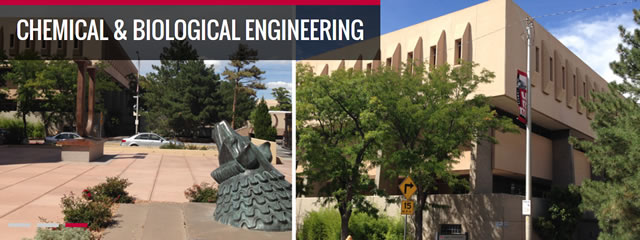
Chemical and Biological Engineering ETDs
Publication Date
8-28-2012
Abstract
Living materials offer the potential for detection-reporter systems based on living cells that are genetically tailored to sense target analytes with high levels of specificity and accuracy. A biotic or living material would allow the development of simple, hand held devices that could be utilized for many applications including industrial process monitoring, environmental remediation, military and defense applications and drug delivery. Many living materials have been developed and characterized but they still lack heightened and prolonged encapsulated cell viability necessary to make the material a candidate for widespread use. One particular material offers several advantages to increase yeast cell viability by integrating the cells into a lipid-silica templated mesoporous silica matrix using an evaporation induced assembly that selects specifically for living cells. This type of integration yielded increased cell viability versus other conventional methods by introducing an artificial fluid lipid bi-layer between the cell plasma membrane and the surrounding silica which aided in protecting the integrated cells. Despite viability improvements, integration by this method still lacks the desired and necessary prolonged cell viability. During the integration process cells are threatened by stresses such as desiccation or oxidation and incompatibility with the bio-nano interface. To reduce the negative impacts of such stresses and further promote integrated cell viability, strategies inspired by extremophillic organisms were investigated by incorporating trehalose, manganese-phosphate buffer and fluid/non-fluid liposomes into the integration process. It was discovered that incuding manganese phosphate buffer with the integration process offered average viability increases of 3-7% versus cells integrated without the buffer. Findings based on a superoxide indicating fluorescent assay suggest that inclusion of manganese phosphate buffer reduces oxidative stress immediately upon integration and that oxidative stress is likely a primary stress in the first few hours of integration. Addition of fluid (DOPC) or non-fluid (DPPC) lipid liposomes also had an impact on integrated cell viability. Both types of lipids offered initial increases in integrated cell viability — non-fluid lipids offered the largest gains of nearly 4-5 fold over a standard control, and 3 times higher than fluid lipid liposomes. Inclusion of non-fluid liposomes (DPPC) also had the best effect of maintaining cell viability during prolonged encapsulation, surpassing viabilities numbers seen for standard silica matrices or matrices containing fluid lipids (DOPC) up to 15 days. Incorporating trehalose had the biggest positive effect on integrated cell viability, surpassing the viability of yeast cells integrated without trehalose by 5 fold, offering initial viabilities near 25-30%. Optimum relative humidity ranges were also established for producing films with and without trehalose. Films containing trehalose providing integrated cells with increased viability at higher relative humidities where as cells integrated into matrices without trehalose preferred mild to moderate humidity levels near 18-20%. As an alternative to the lipid templated mesoporous-silica encapsulation method shown above, three different aqueous silica gels were also tested for their ability to encapsulate an engineered bio-sensing strain of E. coli. This particular strain of bacteria is capable of detecting theophylline, a small organic compound with a chemical structure similar to caffeine, and responding by producing green fluorescent protein (GFP). Cells encapsulated in each gel were subjected to tests that would determine long term viability trends and the ability of the cells to detect theophylline during prolonged encapsulation. The limits of theophylline detection and GFP response curves of the encapsulated cells were also analyzed. Findings indicate that gels made with poly-glycerated silicate (PGS) offered improved viability over gels formed with sodium-silicate based methods — by a margin of 10%-20 after encapsulation for 2-5 weeks. All three aqueous silica matrices offered profound improvements in cell viability (initially and during prolonged encapsulation) versus cells integrated using standard or modified lipid template mespoporous silica matrices. Furthermore, cells encapsulated in PGS gels were slower at producing equivalent GFP fluorescent intensities, under conditions of identical theophylline exposure, versus gels made from sodium-silicate solutions. Theophylline detection thresholds of encapsulated cells had theophylline limits near 1 uM for all three gels which surpassed the reported theophylline detection threshold of the cells tested in solution by a factor of 10. Although each gel shared the same dynamic limit of detection, each matrix offered a distinct fluorescent response curve and also had a concentration range where integrated cells were observed to respond to theophylline exposure best. To that end, it is concluded that material properties/differences of each silica matrix had profound impacts on cell viability, cell ability to grow colonies post encapsulation, theophylline detection response curves and the overall fluorescent intensities of integrated bacterial cells.'
Keywords
Living cell Integration Mesoporous Silica Encapsulation; Biosensors--Biocompatibility., Microencapsulation--Biocompatibility., Riboswitches.
Sponsors
Sandia National Laboratories. AFOSR
Document Type
Thesis
Language
English
Degree Name
Chemical Engineering
Level of Degree
Masters
Department Name
Chemical and Biological Engineering
First Committee Member (Chair)
Carnes, Eric. C
Second Committee Member
Harper, Jason, C.
Third Committee Member
Timmins, Graham, S.
Recommended Citation
Savage, Travis J.. "Methods of cellular integration and techniques for improving encapsulated cell viability for the purpose of developing living materials and cell based bio-sensing materials." (2012). https://digitalrepository.unm.edu/cbe_etds/39
